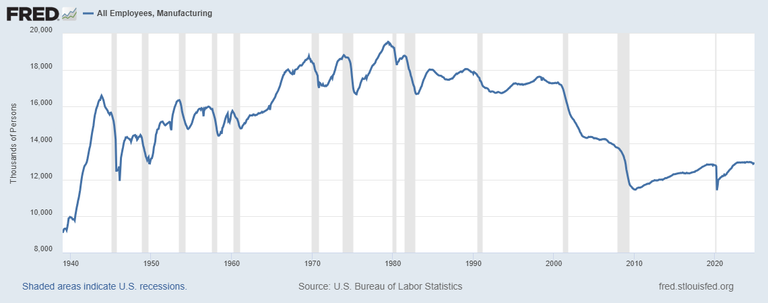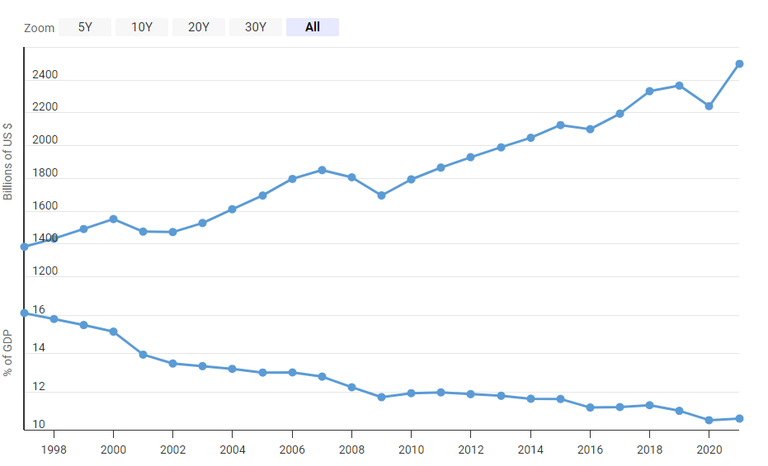Jensen Huang is spending a decent amount of time discussiong AI factories. This is the true game changer for the structure of the economy.
When we things of factories, the tendency is to lean toward manufacturing. This is natural since, for hundreds of years, this is exactly what was output. The world dealt with physical items, made using raw materials.
To briefly go through the process, a plant is built and equipment installed. Once it is running, raw materials are put in with workers running the line. Out comes a finshied product that is sold into the marketplace.
The process is repeated with more materials acquired and additional unit manufactured.
Over the last 40 years, in the developed countries, we saw the number of people involved decline. Here is a chart of the United States showing the number of people working in that industry.
It shows a decline of 6 million people since 1980.

Some like to say the United States doesn/t make anything anymore. This is a false narrative. Here is the total manufacturing production over a 23 year period.

The total number of workers declined by roughly a third yet the output increase by over 80%. I realize it is not exactly the same time periods which should drive the point home even further.
Web 3.0: Combating Big Tech's AI Factories
The robots are coming.
This is a fact people need to wake up to. Humanoid robots are improving with each passing month. We saw a significant jump in capabilities over the last 2 years. Some assert that they are not very capable today, which is true. However, we have to acknowledge we were starting at a very low level at that time.
When it comes to AI factories, I am going to break it down into two types.
One is the physical factory which we all have known about. This is taking the same process as above, yet replacing workers. Instead of people, the majority will be humanoid robots.
By this point, it should be clear the advantage to robots over people. The amount of productivity coming from a robot compared to humans will be large. One of the key reasons for this is the learn once, know forever. In other words, there is only the inititial learning curve.
With humans, each time someone is replaced, there is a new learning curve.
Another major factor is any skills that is acquired is instantly available to every other robot via the next update. Humans might tell each other but that is, at best, a very slow process.
The final piece in this is the sheer volume. When it comes to robots versus people, population growth is of no comparison.
According to Our World in Data, there were 132 million people born globally in 2020. If is likely that we see 1 billion humanoid robots builts in a year during the early 2030s.
That is not a lot of time for the world to adapt.
AI Data Factories
The second is AI data factories.
Most have heard about the hundreds of billions that are pouring into data centers. All the Big Tech companies are involved. They are filling them with massive GPU clusters, being able to train models at an ever growing scale.
Few realize this is another AI factory.
We can look at this similar to the other physical factory:
Factory:
Plant - Neurel Network
Equipment - Algorithms
Workers - Data producers
Raw Materials - Data
Product - Data
There are a few key differences that we have to mention.
The first is that bits move a lot quicker than atoms. When we look at growth and expansion, data factories are a lot quickly that the physical world.
Next we have the data producers. Many think about what humans produce since that is what accounts for the majority of the data. However, that is going to be dwarfed by the data generated via sensors. When trillions of those are installed, including in robots, the totals change a great deal.
The final difference could be the most crucial.
With a traditional factory, the final product is shipped to a customer. The process stops there. Any more production requires the acquisition of another batch of raw materials.
Adding more materials (new data) certainly applies here. That said, there is something else interesting. With a data factory, the output is actually input. Whatever is generted can be fed back into the network, used for training the next geneation models.
Think about that for a second. If every car General Motors ever made was actually input for the manufacturing of more cars, how would that have changed things? How many more cars would have been built, leaving aside nobody would have cars if they were input back into the process.
Data is not a one off. It is easily duplicated and can exist in two areas (or more) simultaneously.
Web 3.0
This is all part of Web 3.0. My view, the next generation Internet is more than just blockchain and cryptocurrency. It also includes robotics, AI, alternative energy forms, and mixed reality. It is a convergence of many technologies, radically changing the structure of society.
Few can dispute the impact of social media and mobile. This is going to be that on steroids.
Web 3.0 does not mean decentralized. Certainly there are part of it that will (have to) be. We are going to see centralized networks operating, using the traditional business structure, i.e. corporation. There will also be tokenized entities that are centralized.
The crux of the entire discussion comes down to the ownership of the means of production. That is what humanity is going to have to determine.
We are going to see things changing quickly. Robotic factories will be eclipsed by the data centers. Remember, with those, we are dealing with congnitive units. That means the entire spectrum of knowledge work is up for grabs.
Posted Using INLEO